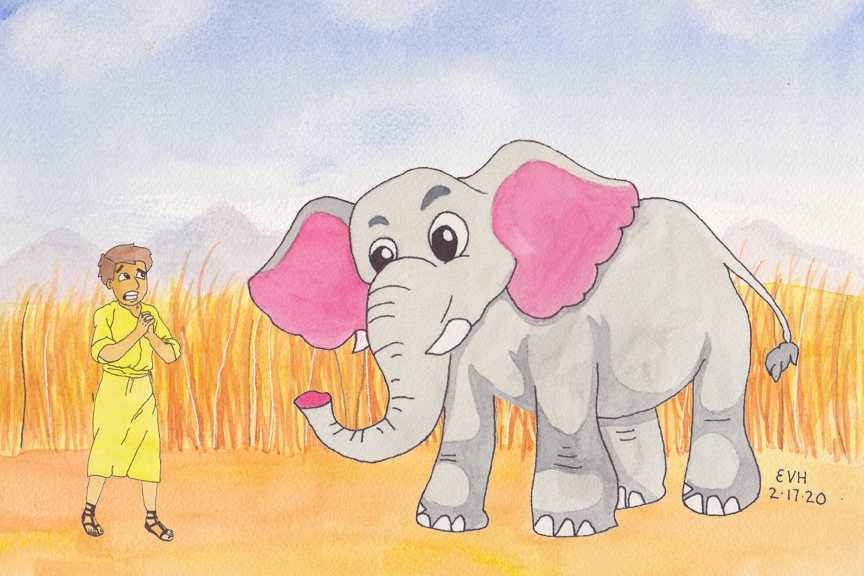
Jataka 221
Kāsāva Jātaka
The Yellow Robe
as told by Eric Van Horn
originally translated by William Henry Denham Rouse, Cambridge University
originally edited by Professor Edward Byles Cowell, Cambridge University
In the Buddhist tradition – going back to the time of the Buddha – monks and nuns wear yellow. It is actually a brown-ish yellow, and the exact color varies by region. During the Buddha’s time, this was considered the poorest dye available, thus wearing yellow robes was a symbol of humility. As Buddhism moved into China, it became traditional to wear gray, brown, or black robes, also symbols of humility. And likewise, Tibetan monks and nuns wear maroon.
But as we see in this story, the humble yellow robe also became a symbol of spiritual accomplishment. And mis-using that symbol comes with dire consequences, karmically speaking if in no other way.
Sadly this story tells a tale that is relevant today, and that is killing elephants for their tusks.
“If any man…” The Master told this story while he was staying at Jetavana. It is about Devadatta.
This story was prompted by something that happened at Rājagaha. At the time the Captain of the Faith (Sāriputta) was living with 500 monks at the Bamboo Grove (Veluvana). And Devadatta, with a group of men who were as wicked as he was, lived at Gayāsīsa.
At that time the citizens of Rājagaha used to get together for the giving of alms. A trader, who had gone there on business, brought a magnificent perfumed yellow robe. He asking if he could be one of the almsgivers, and he give this garment as his contribution.
The townspeople brought plenty of gifts. There was also a great deal of money. But there was this garment left. The crowd that had gathered said, “Here is this beautiful perfumed robe. Who should have it, the Elder Sāriputta or Devadatta?”
Some were in favor of Sāriputta. Others said, “The Elder Sāriputta will only stay here a few days. Then he will go traveling at his own sweet will. But Devadatta always lives near our city. He is our refuge in good fortune or ill. Devadatta should have it!”
They divided into two groups, and those who voted for Devadatta were in the majority. So they gave the robe to Devadatta. He had it cut into strips and sewn back together. It had a color like gold, and so he wore it.
At the same time, 30 monks from Sāvatthi went to salute the Master. After greetings had been exchanged, they told him about this affair, adding, “And so, sir, Devadatta wears the clothing of a saint, which does not suit him at all.”
“Monks,” the Master said, “this is not the first time that Devadatta has put on the clothing of a saint, a most unsuitable dress. He did the same before.” And then he told them this story from the past.
Once upon a time, when Brahmadatta was the King of Benares, the Bodhisatta came into this world as an elephant in the Himalaya Mountains. He was the lord of a herd that numbered 80,000 wild elephants, and he lived in the forest.
A poor man that lived in Benares saw the workers in the ivory bazaar making bangles and all manner of ivory trinkets. He asked them if they would buy elephant tusks if he could get them. To this they answered “Yes.”
So he took a weapon, and - clothing himself in a yellow robe - he pretended to be a Pacceka Buddha (a solitary or non-teaching Buddha). He put a covering band around his head. Then he stood in the path of the elephants and killed one of them with his weapon. He sold its tusks in Benares, and in this way he made a living.
After this he began to kill the very last elephant in the Bodhisatta’s troop. Every day the number of elephants grew fewer and fewer. Then they went to the Bodhisatta and asked how it was that their numbers dwindled. He thought about what might be the cause. “Some man,” he thought, “stands in the place where the elephants go, pretending to be a Pacceka Buddha. I wonder if he is the one who kills the elephants? I will find out.”
So one day he sent the others out in front of him and he followed behind. The man saw the Bodhisatta. He rushed at him with his weapon. But the Bodhisatta turned and stood. “I will beat him into the earth and kill him!” he thought. He stretched out his trunk, but when he saw the yellow robes that the man wore, he thought, “I should pay respect to those sacred robes.” So he drew back his trunk and cried, “Oh man! Isn’t that dress, the symbol of sainthood, unsuitable to you? Why do you wear it?” and he repeated these lines:
“If any man, yet full of sin, should dare
To don the yellow robe, in whom no care
For temperance is found, or love of truth,
He is not worthy such a robe to wear.
He who has tamed desire, who everywhere
Is firm in virtue, and whose chiefest care
Is to control his passions, and be true,
He well deserves the yellow robe to wear.”

Figure: “He is not worthy such a robe to wear.”
With these words the Bodhisatta rebuked the man. He told him never to come there again or he would die for it. Then he drove him away.
After this discourse had ended, the Master identified the birth: “Devadatta was the man who killed the elephants, and I was the head of the herd.”
